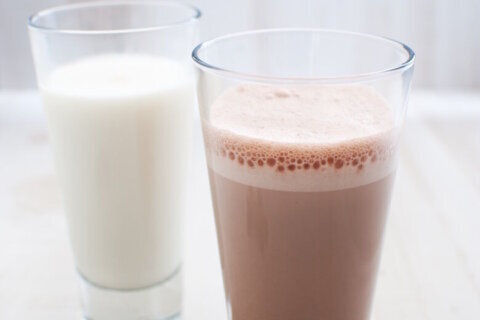At the risk of sounding hyperbolic, I’m going to share my belief that the fiber bar symbolizes everything dysfunctional about our collective relationship with food here in America. For clarity’s sake, I use the term “fiber bar” as an umbrella that includes the extended family of fiber-fortified snack bars, fiber streusel pastries, fiber brownies and fiber cookies. Or basically, any sweet, highly-processed snack food that contains a preternaturally high amount of fiber along the lines of 40 to 70 percent of the daily recommended intake per small serving.
What’s my gripe with fiber bars? They reinforce delusional thinking that we can somehow have our cake (literally) and eat it too; that we don’t need to actually eat whole, fiber-rich foods in order to check off the “fiber” box on our daily nutritional to-do lists. Fiber bars lure us in with a caramel-drizzled, chocolate-coated promise that we can somehow continue to eat empty-calorie snacks loaded with sugar, white flour and a laundry list of artificial ingredients while enjoying the same health benefits as we would from eating whole, fiber-rich foods. Spoiler alert: We can’t.
Defenders of the fiber bar offer many arguments in its favor, none of which I find compelling. For example, since the average American eats half — or less — of the recommended amount of fiber, these sweet and yummy fiber-enhanced snack bars deliver a sizeable and essential infusion of health-promoting fiber in a single snack. They argue that whole, fiber-rich foods aren’t as convenient or portable as bars. These bars, they may also claim, help alleviate constipation. But these virtuous arguments obscure a much simpler truth: Most of us would simply rather eat a candy bar than a handful of nuts and an apple. And we want permission to eat the candy bar.
Here’s the problem: Adequate fiber intake is a means to an end, not the end itself. The end is better health — as measured by prevention of cancer, heart disease and diabetes; healthy weight maintenance; and regular bowel function. And virtually all the studies that link better health outcomes of this nature to higher dietary fiber intake looked at fiber intake from diverse plant-based sources such as whole grains, beans, fruits, vegetables, nuts and seeds — foods that are also high in antioxidants, vitamins, minerals and devoid of added sugar, artificial sweeteners and chemical preservatives. The vast majority of fiber added to fiber bars comes from chicory root extract (aka inulin) and factory-isolated corn starches, blended into a concentrated matrix of sugar and white flour. Where are the studies showing people who get most or all of their fiber from such Trojan Horses have less cancer, lower risk of diabetes, better weight status or improved digestive health? (That was a rhetorical question. There aren’t any.)
Moreover, the reliance on a single type of fiber in very concentrated amounts to achieve one’s fiber goals may have other unintended consequences. Our guts harbor a diverse population of microorganisms referred to as our microbiota, and the health and population of this ecosystem is increasingly understood to play a pivotal role in everything from our weight status and disease risk to our brain function and levels of gut inflammation. The population of our microbiota is shaped heavily by our diets. Diets in which the type of fiber consumed is limited promote a much less diverse array of microbial species, and an overall reduced population of bacteria in general — a finding we’ve already started to see in studies of people who follow the low FODMAP diet. Fiber bars take this phenomenon to the extreme: They allow us to believe we need only consume one or two types of fiber in order to meet most or all of our daily goals, alleviating the pressure to eat fiber-containing fruits, vegetables, whole grains, beans, seeds or nuts on a daily basis. When you replace inulin-spiked fiber bars for a variety of whole foods that contain over a dozen different types of fiber and resistant starches among them, you risk selectively feeding certain microbial species at the expense of others. This has known consequences for microbial diversity … but as-yet unknown consequences for long term health.
There’s no good health reason I can think of to eat a fiber bar, apart from the stranded-on-a-desert-island scenario. If you’re constipated from lack of fiber, take it as your body’s plea to eat some oatmeal with berries for breakfast, and to add a pile of baby carrots or a clamshell of grape tomatoes to your lunch sandwich. Breakfast needs to be on-the-go? Fine: Grab an apple or pack an avocado toast sandwich to eat en route to work. Insist that your portable snacks must come in a crinkly bag? Fine — I’ll play ball. How about a 100-calorie bag of lightly salted popcorn, or a pouch of dry-roasted edamame or chickpeas? Need to quash a mid-afternoon chocolate craving? Mix a fat pinch of dark chocolate chips together with a 100-calorie pack of almonds. Want the prebiotic health benefits of inulin? Great! Snack on some sliced jicama with a squeeze of lime, and save yourself all that sugar. There are dozens of convenient ways to add fiber to your diet from varied sources of whole, plant-based foods — foods whose health benefits extend far beyond their fiber content alone — and dozens of good reasons to do so rather than defaulting to a highly-processed fiber bar.
I suppose if one wanted to eat a candy bar, one could reasonably choose to eat a fiber bar instead. I’d just advise against deluding oneself into thinking its health food. Or frankly, even healthy-ish food. Or for that matter, even actual ‘food’ to begin with.
More from U.S. News
The 10 Best Heart-Healthy Diets
The Fertility Preservation Diet: How to Eat if You Want to Get Pregnant
The Fiber Bar: a Food That Deludes originally appeared on usnews.com







